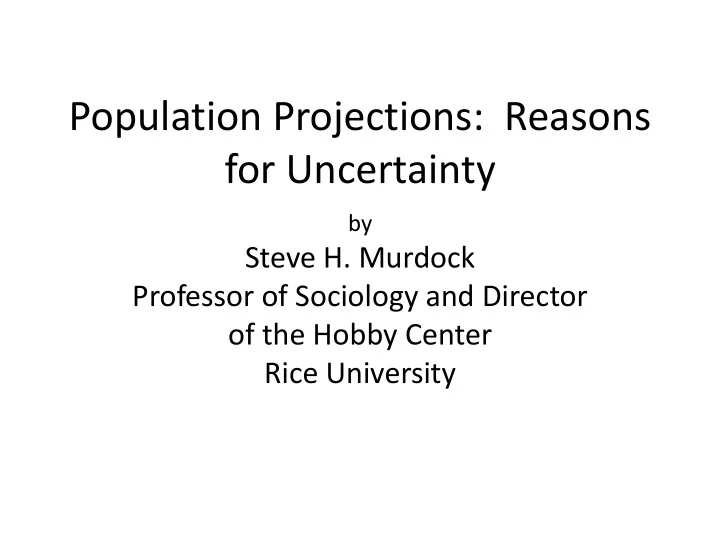

Population Projections: Reasons for Uncertainty by Steve H. Murdock Professor of Sociology and Director of the Hobby Center Rice University
Demographic Axiom No wise demographer should ever make a population projection for any period of time that he or she does not expect to exceed his or her lifetime
Component Methods Uses three components of Population Change: 𝐐 𝐮 𝟑 = 𝐐 𝐮 𝟐 + 𝐂 𝐮 𝟐 −𝐮 𝟑 − 𝐄 𝐮 𝟐 −𝐮 𝟑 + 𝐎𝐍 𝐮 𝟐 −𝐮 𝟑 Where: P t 2 = population for estimate period P t 1 = population for base period B t 1 − t 2 = births between P t 1 and P t 2 D t 1 − t 2 = deaths between P t 1 and P t 2 NM t 1 − t 2 = net migration between P t 1 and P t 2
Basic Method of Population Projection Steps in Making Projections Using Component Methods 1. Determine the base population (usually from recent population counts). 2. Determine baseline fertility, mortality and migration rates 3. Determine future fertility, mortality and migration rates
Major Agencies Completing World Population Projections • United Nations--First Set produced in 1958 • United States Census Bureau--Since the 1940s • The World Bank--Since 1978 Other Entities Producing Projections -Population Reference Bureau (since the 1970s) -International Institute for Applied Systems Analysis (Since the 1990s) -Several entities periodically but not continuously
Source: United Nations Department of Economic and Social Affairs/Population Division (2004) World Population to 2300 .
Source: Lutz, Wolfgang (2001 ) World Population in 2050: Assessing the Projections. Discussion. Paper presented at the Federal Reserve Bank of Boston Conference “Seismic Shifts: The Economic Impact of Demographic Change.”
Lutz Synopsis of Projections • “The results show about an 85 percent probability that world population will reach a maximum (over 14 billion) over the course of this century and then start to decline. There is about a 60 percent probability that world population will not reach 10 billion before 2100, and around a 15 percent probability that in 100 years, world population will be even lower than today.” Source: Lutz, Wolfgang (2001 ) World Population in 2050: Assessing the Projections. Discussion. Paper presented at the Federal Reserve Bank of Boston Conference “Seismic Shifts: The Economic Impact of Demographic Change.
Global Population Size from 2000 to 2300 Resulting from Alternative Global Fertility Levels as Indicated (TFR to be Reached by 2030-2050 and Kept Constant) Combined with a Maximum Life Expectancy of 90. Source: Basten, Stuart, Wolfgang Lutz, and Sergei Scherbov (2013). Very Long Range Global Population Scenarios to 2300 and the Implications of Sustained Low Fertility,” Demographic Research. Vol. 28(39), pgs. 1145-1166.
Global Population Size from 2000 to 2300 Resulting from Alternative Global Fertility Levels as Indicated (TFR to be Reached by 2030-2050 and Kept Constant) Combined with a Maximum Life Expectancy of 100. Source: Basten, Stuart, Wolfgang Lutz, and Sergei Scherbov (2013). Very Long Range Global Population Scenarios to 2300 and the Implications of Sustained Low Fertility,” Demographic Research. Vol. 28(39), pgs. 1145-1166.
Global Population Size from 2000 to 2300 Resulting from Alternative Global Fertility Levels as Indicated (TFR to be Reached by 2030-2050 and Kept Constant) Combined with a Maximum Life Expectancy of 120. Source: Basten, Stuart, Wolfgang Lutz, and Sergei Scherbov (2013). Very Long Range Global Population Scenarios to 2300 and the Implications of Sustained Low Fertility,” Demographic Research. Vol. 28(39), pgs. 1145-1166.
United States Projections • Assessment of the accuracy of components of long-term population projections • Assessment of the accuracy of components of short-term population projections
Areas of Uncertainty in Population Projections • Current rates of fertility, mortality and net migration • Trends in fertility, mortality and net migration rates over the projection period – Assume they do not change or only some (such as fertility levels) change or that trends in rates continue – Assume change in rates for “developed” nations are indicative of those for all nations – Assume target levels such as life expectancies, total fertility rates, (and, if applicable) immigration rates will not exceed a given level
Factors Impacting Levels of Uncertainty in Demographic Processes and Projections • Economic conditions and trends (e.g. high, medium or low economic growth) affect fertility, mortality and migration • Societal values and beliefs regarding demographic processes (e.g. fertility and family size) • Religious beliefs and restrictions • Physical capabilities and limitations related to age and disease, etc. • Disease, health and medical service conditions (AIDS, pandemics, etc.) • Physical and environment conditions (drought, climate change, etc.)
Summary • Projections of population like that of other factors are subject to numerous sources of error particularly for extended periods of time into the future; • Multiple scenarios are required for projections in order to anticipate and bracket potential patterns of growth; • Potential for errors in projections are substantial and must be accepted as a part of the projections process and addressed as effectively as possible
Recommend
More recommend